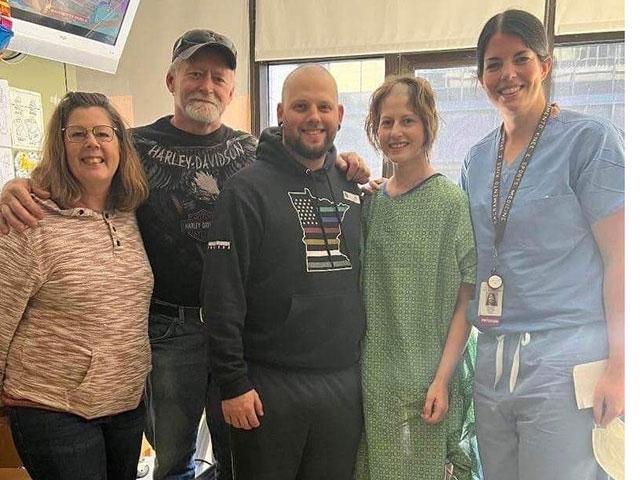Woman Survives Being Trampled by Steer
24-Year-Old Woman Survives Being Trampled by Steer
OMAHA (DTN) -- In March, Buffalo, Minnesota farmer Don Czanstkowski was loading four steers into a trailer for market. Helping her father as she always does, his 24-year-old daughter Rachel Sands stood off to the side.
Suddenly, a scared steer turned around and ran toward her. The 1,500-pound steer knocked the mother of two down, bruised her legs and stepped on her heart as he tried to run toward the fence.
Sands lifted herself off the ground and climbed atop a fence for safety, but by then her heart started to hurt.
"She wasn't up there long before her head started to nod forward and she started going unconscious," Czanstkowski told DTN.
Within seconds, Czanstkowski lowered her to the snow-covered Minnesota ground, held her and called 911. Her mom, Michele, swiftly removed her coat to provide a barrier between Sands and the snow.
As the family waited for first responders, Sands' breath rapidly faded, but she still had a pulse. Upon the arrival of the first responders, she was transported to the nearest airport, a few miles from the family's farm. She was then airlifted to Hennepin County Medical Center in Minneapolis. She suffered four strokes on the way to the hospital.
AT THE HOSPITAL
"They determined she had blood around her heart, the sack that her heart is in, and they used a needle to get some of that out, which allowed them enough time to get into the operating room." Czanstkowski explained.
"But as soon they opened her chest, her heart stopped," he said.
After about 20 minutes of no heartbeat, the medical team was able to revive her.
They stitched up the places in her heart that had been bleeding. In the days to come, doctors worked relentlessly to stop the bleeding of her heart and drain the fluid around her lungs and brain. Sands went through four open heart surgeries.
P[L1] D[0x0] M[300x250] OOP[F] ADUNIT[] T[]
Dr. Alex Coward told the family, "If Rachel's heart would have stopped anywhere other than the operating room, she wouldn't be here with us today."
"The doctor gave Rachel a 1% chance of pulling through," Czanstkowski said. "But she had a lot to fight for, and she had a lot of people fighting for her."
As she continued to fight for her life, her survival story spread of how miraculous and rare it was.
She has no memory of the incident itself.
COMING HOME
Sands spent three weeks in the hospital before going home. Sands and her husband Jared, who serves in the National Guard, have two kids, aged 4 and 1. While in the hospital and through recovery, her family has been supportive and overall thankful that she survived.
"We were talking about bringing her 4-year-old in to see her, but everything progressed so fast, we never brought him in. We did Facetime when she was able to talk again. That was one of the happiest days of my life," Czanstkowski told DTN.
"I remember I talked to my dad first, I remember my voice being raspy," Sands added.
She shared that she is still undergoing some outpatient therapy. Nearly two months since the tragedy, Sands is experiencing some issues with memory, but is expected to recover.
Although limited on weight restrictions and what she can do, one thing she won't stop doing is helping on her parents' farm.
"I love farming, being around the animals and the atmosphere," Sands said. "I'm feeling a lot better than I was; I'm still in disbelief that it happened."
From start to finish, Sands went from having a 1% chance of survival, to making it back home, walking and talking, and moving all her body parts.
To help cover medical costs, Sands' best friend Hailey Fuglseth is hosting a "Ride for Rachel" horse show on Aug. 26 at 9 a.m. CDT at the Buffalo, Minnesota, PRCA Rodeo Grounds. The family is also raising money through GiveSendGo: https://www.givesendgo.com/….
HOW TO ADVOID LIVESTOCK INJURIES
While the exact cause of Rachel's life-threatening injury seems unavoidable, one thing farmers and ranchers can do when handling livestock is to ask for help.
"Have plenty of help and be aware of what's going on. This can happen to anyone," Czanstkowski said.
The Upper Midwest Agricultural Safety and Health Center has noted online that "Stressed livestock are more likely to injure themselves, their handlers, and are more difficult to work with. Providing stockmanship training for workers handling livestock is key to preventing injuries. There may also be changes you can make in your buildings, gates, and working areas that will minimize distractions and startling objects."
According to the Centers for Disease Control and Prevention, every year cattle are responsible for an average of 22 human deaths in the U.S. In a study released in 2021 from Penn State, researchers looked at emergency room admissions across the United States over a five-year period and found that 60,000 people were treated in emergency departments for nonfatal, agricultural-related injuries.
In 2019, the U.S. Bureau of Labor Statistics reported 573 fatalities, or an equivalent of 23.1 deaths per 100,000 workers.
To mitigate risk of injuries during livestock handling, the Upper Midwest Agricultural Safety and Health Center released a safety checklist to ensure safe handling. The downloadable checklist can be found at https://umash.umn.edu/…, along with a series of training videos on stockmanship and low-stress animal handling techniques.
Ohio State University Extension also has some tips at https://agnr.osu.edu/…, and the U.S. Agricultural Safety and Health Centers has videos on YouTube at https://www.youtube.com/… to teach safety with several types of livestock.
Susan Payne can be reached at susan.payne@dtn.com
Follow her on Twitter @jpusan
(c) Copyright 2023 DTN, LLC. All rights reserved.




